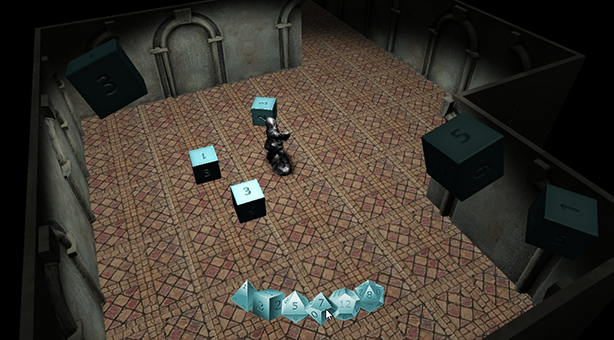 The one feature that I knew I wanted for dice was rolling the dice directly on the map and watching them clatter about and bounce of the walls, floors, and miniatures. I wanted to avoid using the Unity physics primarily because it’s non-deterministic and, like most physics engines, a bit squirrely and unpredictable.
The one feature that I knew I wanted for dice was rolling the dice directly on the map and watching them clatter about and bounce of the walls, floors, and miniatures. I wanted to avoid using the Unity physics primarily because it’s non-deterministic and, like most physics engines, a bit squirrely and unpredictable.
I spent a fair amount of time investigating other possibilities and I was getting close to a workable solution, but it was ultimately going to consume too much time and effort to develop a custom die-rolling system. I chose, instead, to go ahead and implement dice rolling with using the built-in physics. The Unity documentation specifically calls out scale as an issue with their physics engine. The presumption is that 1 unit = 1 meter and the physics are calculated using that scale. It’s not modifiable.
Fortunately, when I began the project, I knew that the scale of the map may one day be a factor and that day was today. I included a global scale factor that let’s me arbitrarily modify the overall scale of the world. I’ve been working at a scale of 40 (an entirely made-up test number). To get the physics simulation of the dice to look at all correct, I had to set the world scale down to 0.5. To get a true representation of 25mm figures, I’d need to set the scale to 0.025. Unfortunately, the physics simulations fall apart at that size.
The second issue with the smaller scale is that the font rendering in Unity does not like tiny fonts. Fonts that once rendered well, now are all blurry. For dynamic fonts, Unity uses OS specific font renderers and the Windows renderer does not like font sizes that small. I may have to create custom textures for the movement costs. Other than the text, I have a few issues still to resolve.
1) I’m determining the value of the roll by checking the orientation of the die when it comes to rest. Sometimes the simulation results in a “cocked die” that isn’t lying flat on the surface. Currently that is resulting in a value of 0, but it’s addressable. For dice that are really cattywampus, the die can just be re-rolled. For those that are pretty close to flat, I’ll have to adjust the calculations to allow for a greater range of orientations.
2) Sometimes the dice fall off of the table. Constructing an invisible box to contain the dice, or just an invisble plane, should be enough. It’s just on the to-do list.
3) At the moment, I’m only rolling six-sided dice. Determining the facing side of a d20 is significantly more involved. I have some work with pen-paper to figure out the best way to handle polyhedral dice. Worst case is a look-up table. For the standard six dice, this shouldn’t be too bad. It’s only eight if I included the d30 and d100.
Most importantly, rolling the dice is pretty fun. It has much of the same satisfaction of rolling real dice on a table. Take a look as I roll some dice. Lots of dice.

Is there a way to put more English on them so they bounce and roll more? Some of them aren’t turning over at all, which looks wrong even though the number is still random. Like those guys that shake the hell out of the dice in their hands and then just turn them over onto the table. They (usually) aren’t cheating, but it feels like they are.
The physics on the dice are straight out of the box. There are all kinds of bounce and friction settings that can be tweaked. You’re right that it’s a random number, no matter what the dice look like, but this is exactly the kind of feedback that is useful when you’re too close to the action to always see the big picture.